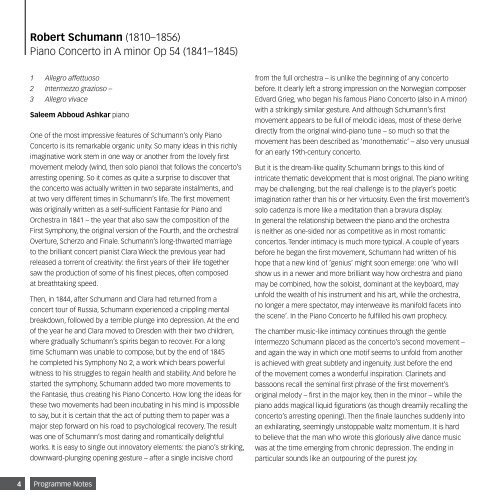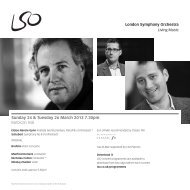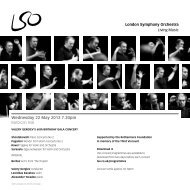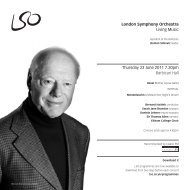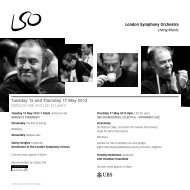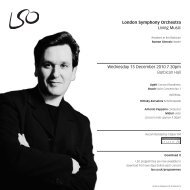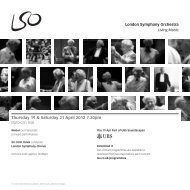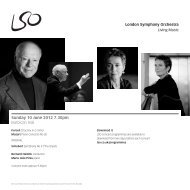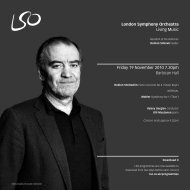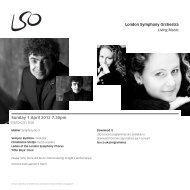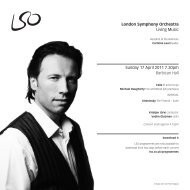Sunday 30 October 2011 - London Symphony Orchestra
Sunday 30 October 2011 - London Symphony Orchestra
Sunday 30 October 2011 - London Symphony Orchestra
You also want an ePaper? Increase the reach of your titles
YUMPU automatically turns print PDFs into web optimized ePapers that Google loves.
Robert Schumann (1810–1856)<br />
Piano Concerto in A minor Op 54 (1841–1845)<br />
1 Allegro affettuoso<br />
2 Intermezzo grazioso –<br />
3 Allegro vivace<br />
Saleem Abboud Ashkar piano<br />
One of the most impressive features of Schumann’s only Piano<br />
Concerto is its remarkable organic unity. So many ideas in this richly<br />
imaginative work stem in one way or another from the lovely first<br />
movement melody (wind, then solo piano) that follows the concerto’s<br />
arresting opening. So it comes as quite a surprise to discover that<br />
the concerto was actually written in two separate instalments, and<br />
at two very different times in Schumann’s life. the first movement<br />
was originally written as a self-sufficient Fantasie for Piano and<br />
<strong>Orchestra</strong> in 1841 – the year that also saw the composition of the<br />
First <strong>Symphony</strong>, the original version of the Fourth, and the orchestral<br />
Overture, Scherzo and Finale. Schumann’s long-thwarted marriage<br />
to the brilliant concert pianist Clara Wieck the previous year had<br />
released a torrent of creativity: the first years of their life together<br />
saw the production of some of his finest pieces, often composed<br />
at breathtaking speed.<br />
then, in 1844, after Schumann and Clara had returned from a<br />
concert tour of Russia, Schumann experienced a crippling mental<br />
breakdown, followed by a terrible plunge into depression. At the end<br />
of the year he and Clara moved to Dresden with their two children,<br />
where gradually Schumann’s spirits began to recover. For a long<br />
time Schumann was unable to compose, but by the end of 1845<br />
he completed his <strong>Symphony</strong> No 2, a work which bears powerful<br />
witness to his struggles to regain health and stability. And before he<br />
started the symphony, Schumann added two more movements to<br />
the Fantasie, thus creating his Piano Concerto. How long the ideas for<br />
these two movements had been incubating in his mind is impossible<br />
to say, but it is certain that the act of putting them to paper was a<br />
major step forward on his road to psychological recovery. the result<br />
was one of Schumann’s most daring and romantically delightful<br />
works. It is easy to single out innovatory elements: the piano’s striking,<br />
downward-plunging opening gesture – after a single incisive chord<br />
4 Programme Notes<br />
from the full orchestra – is unlike the beginning of any concerto<br />
before. It clearly left a strong impression on the Norwegian composer<br />
edvard Grieg, who began his famous Piano Concerto (also in A minor)<br />
with a strikingly similar gesture. And although Schumann’s first<br />
movement appears to be full of melodic ideas, most of these derive<br />
directly from the original wind-piano tune – so much so that the<br />
movement has been described as ’monothematic’ – also very unusual<br />
for an early 19th-century concerto.<br />
But it is the dream-like quality Schumann brings to this kind of<br />
intricate thematic development that is most original. the piano writing<br />
may be challenging, but the real challenge is to the player’s poetic<br />
imagination rather than his or her virtuosity. even the first movement’s<br />
solo cadenza is more like a meditation than a bravura display.<br />
In general the relationship between the piano and the orchestra<br />
is neither as one-sided nor as competitive as in most romantic<br />
concertos. tender intimacy is much more typical. A couple of years<br />
before he began the first movement, Schumann had written of his<br />
hope that a new kind of ’genius’ might soon emerge: one ’who will<br />
show us in a newer and more brilliant way how orchestra and piano<br />
may be combined, how the soloist, dominant at the keyboard, may<br />
unfold the wealth of his instrument and his art, while the orchestra,<br />
no longer a mere spectator, may interweave its manifold facets into<br />
the scene’. In the Piano Concerto he fulfilled his own prophecy.<br />
the chamber music-like intimacy continues through the gentle<br />
Intermezzo Schumann placed as the concerto’s second movement –<br />
and again the way in which one motif seems to unfold from another<br />
is achieved with great subtlety and ingenuity. Just before the end<br />
of the movement comes a wonderful inspiration. Clarinets and<br />
bassoons recall the seminal first phrase of the first movement’s<br />
original melody – first in the major key, then in the minor – while the<br />
piano adds magical liquid figurations (as though dreamily recalling the<br />
concerto’s arresting opening). then the finale launches suddenly into<br />
an exhilarating, seemingly unstoppable waltz momentum. It is hard<br />
to believe that the man who wrote this gloriously alive dance music<br />
was at the time emerging from chronic depression. the ending in<br />
particular sounds like an outpouring of the purest joy.


